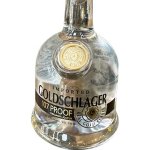Colloidal gold is a sol or colloidal suspension of nanoparticles of gold in a fluid, usually water.[1] The colloid is coloured usually either wine red (for spherical particles less than 100 nm) or blue-purple (for larger spherical particles or nanorods).[2] Due to their optical,[3] electronic, and molecular-recognition properties, gold nanoparticles are the subject of substantial research, with many potential or promised applications in a wide variety of areas, including electron microscopy, electronics,[4] nanotechnology, materials science,[5] and biomedicine.[6][7][8][9]
The properties of colloidal gold nanoparticles, and thus their potential applications, depend strongly upon their size and shape.[10] For example, rodlike particles have both a transverse and longitudinal absorption peak, and anisotropy of the shape affects their self-assembly.[11]
...
Synthesis
Generally, gold nanoparticles are produced in a liquid ("liquid chemical methods") by reduction of chloroauric acid (H[AuCl4]). To prevent the particles from aggregating, stabilizing agents are added. Citrate acts both as the reducing agent and colloidal stabilizer.
They can be functionalized with various organic ligands to create organic-inorganic hybrids with advanced functionality.[17]
Turkevich method
This simple method was pioneered by J. Turkevich et al. in 1951[107][108] and refined by G. Frens in the 1970s.[109][110] It produces modestly monodisperse spherical gold nanoparticles of around 10–20 nm in diameter. Larger particles can be produced, but at the cost of monodispersity and shape. In this method, hot chloroauric acid is treated with sodium citrate solution, producing colloidal gold. The Turkevich reaction proceeds via formation of transient gold nanowires. These gold nanowires are responsible for the dark appearance of the reaction solution before it turns ruby-red.[111]
Capping agents
A capping agent is used during nanoparticle synthesis to inhibit particle growth and aggregation. The chemical blocks or reduces reactivity at the periphery of the particle—a good capping agent has a high affinity for the new nuclei.[112] Citrate ions or tannic acid function both as a reducing agent and a capping agent.[113][114] Less sodium citrate results in larger particles.
Brust-Schiffrin method
This method was discovered by Brust and Schiffrin in the early 1990s,[115] and can be used to produce gold nanoparticles in organic liquids that are normally not miscible with water (like toluene). It involves the reaction of a chlorauric acid solution with tetraoctylammonium bromide (TOAB) solution in toluene and sodium borohydride as an anti-coagulant and a reducing agent, respectively.
Here, the gold nanoparticles will be around 5–6 nm.[116] NaBH4 is the reducing agent, and TOAB is both the phase transfer catalyst and the stabilizing agent.
TOAB does not bind to the gold nanoparticles particularly strongly, so the solution will aggregate gradually over the course of approximately two weeks. To prevent this, one can add a stronger binding agent, like a thiol (in particular, alkanethiols), which will bind to gold, producing a near-permanent solution.[117][118] Alkanethiol protected gold nanoparticles can be precipitated and then redissolved. Thiols are better binding agents because there is a strong affinity for the gold-sulfur bonds that form when the two substances react with each other.[119] Tetra-dodecanthiol is a commonly used strong binding agent to synthesize smaller particles.[120] Some of the phase transfer agent may remain bound to the purified nanoparticles, this may affect physical properties such as solubility. In order to remove as much of this agent as possible, the nanoparticles must be further purified by soxhlet extraction.
Perrault method
This approach, discovered by Perrault and Chan in 2009,[121] uses hydroquinone to reduce HAuCl4 in an aqueous solution that contains 15 nm gold nanoparticle seeds. This seed-based method of synthesis is similar to that used in photographic film development, in which silver grains within the film grow through addition of reduced silver onto their surface. Likewise, gold nanoparticles can act in conjunction with hydroquinone to catalyze reduction of ionic gold onto their surface. The presence of a stabilizer such as citrate results in controlled deposition of gold atoms onto the particles, and growth. Typically, the nanoparticle seeds are produced using the citrate method. The hydroquinone method complements that of Frens,[109][110] as it extends the range of monodispersed spherical particle sizes that can be produced. Whereas the Frens method is ideal for particles of 12–20 nm, the hydroquinone method can produce particles of at least 30–300 nm.
Martin method
This simple method, discovered by Martin and Eah in 2010,[122] generates nearly monodisperse "naked" gold nanoparticles in water. Precisely controlling the reduction stoichiometry by adjusting the ratio of NaBH4-NaOH ions to HAuCl4-HCl ions within the "sweet zone," along with heating, enables reproducible diameter tuning between 3–6 nm. The aqueous particles are colloidally stable due to their high charge from the excess ions in solution. These particles can be coated with various hydrophilic functionalities, or mixed with hydrophobic ligands for applications in non-polar solvents. In non-polar solvents the nanoparticles remain highly charged, and self-assemble on liquid droplets to form 2D monolayer films of monodisperse nanoparticles.
Nanotech studies
Bacillus licheniformis can be used in synthesis of gold nanocubes with sizes between 10 and 100 nanometres.[123] Gold nanoparticles are usually synthesized at high temperatures in organic solvents or using toxic reagents. The bacteria produce them in much milder conditions.
Navarro et al. method
For particles larger than 30 nm, control of particle size with a low polydispersity of spherical gold nanoparticles remains challenging. In order to provide maximum control on the NP structure, Navarro and co-workers used a modified Turkevitch-Frens procedure using sodium acetylacetonate as the reducing agent and sodium citrate as the stabilizer.[124]
Sonolysis
Another method for the experimental generation of gold particles is by sonolysis. The first method of this type was invented by Baigent and Müller.[125] This work pioneered the use of ultrasound to provide the energy for the processes involved and allowed the creation of gold particles with a diameter of under 10 nm. In another method using ultrasound, the reaction of an aqueous solution of HAuCl4 with glucose,[126] the reducing agents are hydroxyl radicals and sugar pyrolysis radicals (forming at the interfacial region between the collapsing cavities and the bulk water) and the morphology obtained is that of nanoribbons with width 30–50 nm and length of several micrometers. These ribbons are very flexible and can bend with angles larger than 90°. When glucose is replaced by cyclodextrin (a glucose oligomer), only spherical gold particles are obtained, suggesting that glucose is essential in directing the morphology toward a ribbon.
Block copolymer-mediated method
An economical, environmentally benign and fast synthesis methodology for gold nanoparticles using block copolymer has been developed by Sakai et al.[127] In this synthesis methodology, block copolymer plays the dual role of a reducing agent as well as a stabilizing agent. The formation of gold nanoparticles comprises three main steps: reduction of gold salt ion by block copolymers in the solution and formation of gold clusters, adsorption of block copolymers on gold clusters and further reduction of gold salt ions on the surfaces of these gold clusters for the growth of gold particles in steps, and finally its stabilization by block copolymers. But this method usually has a limited-yield (nanoparticle concentration), which does not increase with the increase in the gold salt concentration. Ray et al.[128] improved this synthesis method by enhancing the nanoparticle yield by manyfold at ambient temperature.
...






